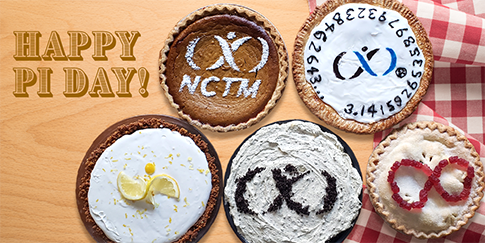Celebrate Pi Day with NCTM
There are many fun and innovative ways to celebrate Pi Day in your classroom and beyond—you probably already use it as a jumping-off point for key mathematical lessons. If you're in need of something to invigorate your tried-and-true Pi Day traditions, NCTM has you covered! We've gathered our best pi-related activities from each of our publications and resources that will suit your grade level. Try them with your students throughout the month of March and share the fun with others on social media. Be sure to include the hashtag #PiDay and tag @NCTM!

Elementary School
Out on the playground, small groups of children are running around with clipboards and long strips of paper. It is “Pi Day,” and the groups are made up of sixth-grade and kindergarten students. The younger students are trying to find circle patterns and then, with the help of their sixth-grade buddies, measure and record the circumferences and diameters.
If a tree could talk, we could ask it how old it is. Here is a mathematical way to estimate the age of your schoolyard trees. Students will measure circumference of trees in order to find diameter and calculate age of local trees using a growth rate table.
Estimate the number of pennies that you can fit on a sheet of paper, then evaluate your estimate.
Compare the radii of three sprinklers in a garden.
Middle School
Why does the same value of pi appear in both formulas for the circumference and area of a circle? This activity presents interesting ways to approach pi. It illustrates a way in which students can estimate the ratio of the area of the circle to the radius square, and also helps students understand why the same value of pi appears in both formulas for the circumference and the area of a circle.
Studying historical puzzles can give students a perspective on the usefulness of math as a tool and on the creative aspects of problem solving. Di Day offers a wonderful opportunity for such inquiry.
In our earnest desire to educate our students about the great importance and significance of the number π by celebrating with special mathematical activities on March 14, we just may be teaching a concept that we had not intended or that we are overlooking altogether. Terrel Trotter Jr., is referring here to the fundamental concept of the place-value structure of our decimal number system.
Pi (MTLT)
What can you discover about pi with a compass and straightedge?
This unit is full of investigations and interactives that students can use to understand pi as a ratio; to understand how pi relates to the area of a circle as well as its circumference; and to understand what area, circumference, radius, and diameter each tell us about circles (check out the “Problems” tab on the Circle Tool interactive and get your students talking about grazing goats).
Help figure out the area of the deck of a carousel using only one measurement.
High School
If students are in an advanced mathematics class, then at some point they enjoyed mathematics and looked forward to learning and practicing it. There is no reason that this passion and enjoyment should ever be lost because the subject becomes more difficult or rigorous. Try this lesson with your students as they use pi and the necessary formulas to divide a round cookie.
The District Hand Pie and Coffee Bar in New Orleans is a delightful place for pie and pi lovers.
GeoGebra can be used to create dynamic figures to duplicate Archimedes' process of approximating and illustrate how the accuracy can be improved.
Even in the absence of a decimal number system and the support of technology, Archimedes described the first iterative process for approximating the value of π in Measurement of a Circle (ca. 225 BCE).
This classroom inquiry covers expressing pi as the limit of a sequence of different ratios using relationships among coins and the radius of an inscribed circle.
Students learn about the relationship between circumference and diameter in the east garden of a Salvador Dali Museum exhibit.
This pi day, why not have students get in a pi fight? Okta, the octopus, hangs out near different coordinates on a unit circle, and students must choose an angle and distance to fire a pie at Okta. This activity is designed to help students practice their fluency with radian and degree measures of special angles on the unit circle and to introduce the concept of polar coordinates. In honor of pi day, students can play Okta’s Pi Fight in radian mode.
Pi Line (Illuminations)
Do your algebra 1 students know that pi, because it is a ratio, is also a slope? In the Pi Line investigation from Illuminations, students “unwrap” circles of diameter x and place those unwrapped circles perpendicular to the x-axis. Before you have students explore these unwrapped circles, have them predict what the graph of the unwrapped circles will look like. Will it be linear? Or will it be curved like a circle? Either before or after students construct their graph, they can grapple with what slope and rate of change would mean in this context. How would your students finish this sentence: “Increasing the diameter of a circle by one unit ______________ the circumference by __________________.”? Does their answer change after this investigation?
These sets of non-routine questions about a single topic are designed to have entry points for students in middle school and to stretch students in high school mathematics. Whether you use this as an independent investigation for students to see how far they get, or choose certain problems for small group or whole-class work, the explorations will have students looking at areas of all sorts of shapes based on folding and cutting paper circles.